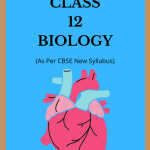NCERT Class 12 Biology Chapter 7 Evolution Solutions to each chapter is provided in the list so that you can easily browse through different chapters NCERT Class 12 Biology Chapter 7 Evolution and select need one. NCERT Class 12 Biology Chapter 7 Evolution Question Answers Download PDF. NCERT Biology Class 12 Solutions.
NCERT Class 12 Biology Chapter 7 Evolution
Also, you can read the NCERT book online in these sections Solutions by Expert Teachers as per Central Board of Secondary Education (CBSE) Book guidelines. CBSE Class 12 Biology Solutions are part of All Subject Solutions. Here we have given NCERT Class 12 Biology Chapter 7 Evolution Notes, NCERT Class 12 Biology Textbook Solutions for All Chapters, You can practice these here.
Evolution
Chapter: 7
BIOLOGY
UNIT – II GENETICS AND EVOLUTION
TEXT BOOK QUESTIONS ANSWERS
Q. 1. Explain antibiotic resistance observed in bacteria in light of Darwinian selection theory.
Ans: (i) Natural selection is a process in which heritable variations that enable better survival reproduce and leave greater number of progeny.
(ii) It occurs due to mutation; variation due to recombination during gametogenesis; gene flow and genetic drift.
(iii) Directional selection (Progressive selection): Population changes towards one direction. More individuals acquire value other than the mean character value.
(iv) E.g. antibiotics resistance to bacteria.
Q. 2. Find out from newspapers and popular science articles any new fossil discoveries or controversies about evolution.
Ans: Fossils of dinosaurs have revealed the evolution of reptiles in Jurassic period.
Q. 3. Attempt giving a clear definition of the term species.
Ans: Species is defined as sexually interbreeding organisms separated from other species by reproductive isolation.
Q. 4. Try to trace the various components of human evolution (hint: brain size and function, skeletal structure, dietary preference, etc.)
Ans: Various Stages of Human Evolution on the basis of brain size and function, skeletal structure, dietary preference are:
Dryopithecus → Ramapithecus → Australopithecus → Homo habilis → Homo erectus → Neanderthal man → Homo sapiens sapiens.
Q. 5. Find out through internet and popular science articles whether animals other than man have self-consciousness.
Ans: Examples of an animal being self – conscious is dolphins, chimpanzee, gorilla.
Q. 6. List 10 modern-day animals and using the internet resources link it to a corresponding ancient fossil. Name both.
Ans: The modern day animals and their ancient fossils are:
1. Man – Ramapithecus.
2. Horse – Eohippus.
3. Dog – Leptocyon.
4. Camel – Protylopus.
5. Elephant – Mothers.
6. Whale – Protocetus.
7. Fish – Arandaspis.
8. Tetrapods – Ichthyostega.
9. Bat – Archaeonycteris.
10. Giraffe – Palaeotragus.
Q. 7. Describe one example of adaptive radiation.
Ans: The process of evolution in which different species start from common point in a geographical area and radiate to other areas of geography (habitats) is called adaptive radiation e.g.Darwin’s finches of the Galapagos Islands: Darwin’s finches are varieties of small black birds on the basis of shape of beaks and feeding habits.
Q. 8. Can we call human evolution as adaptive radiation?
Ans: No, human evolution cannot be called adaptive radiation because human evolution is a gradual process that took place slowly in time.
Q. 9. Using various resources such as your school library or the internet and discussions with your teacher, trace the evolutionary stages of any one animal say horse.
Ans: The evolutionary stages of horse are:
(i) Eohippus.
(ii) Mesohippus.
(iii) Merychippus.
(iv) Pliohippus.
(v) Equus or the modern horse.

Hi! my Name is Parimal Roy. I have completed my Bachelor’s degree in Philosophy (B.A.) from Silapathar General College. Currently, I am working as an HR Manager at Dev Library. It is a website that provides study materials for students from Class 3 to 12, including SCERT and NCERT notes. It also offers resources for BA, B.Com, B.Sc, and Computer Science, along with postgraduate notes. Besides study materials, the website has novels, eBooks, health and finance articles, biographies, quotes, and more.




